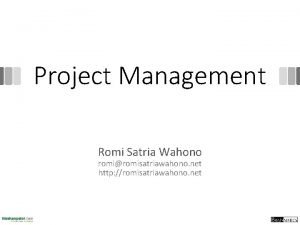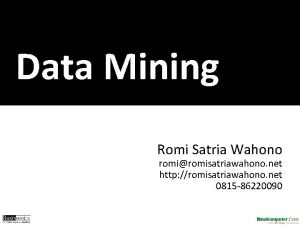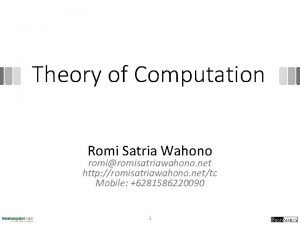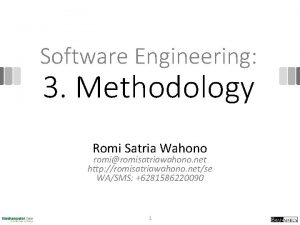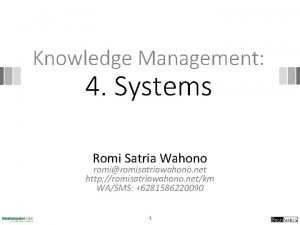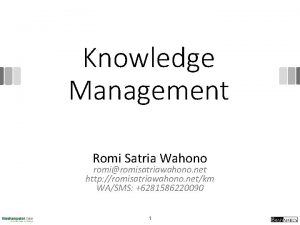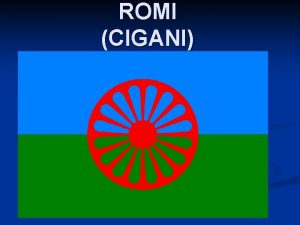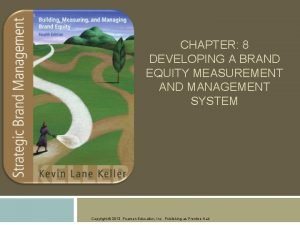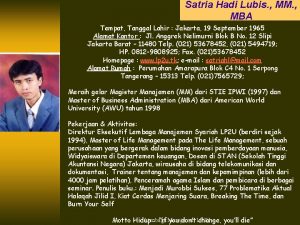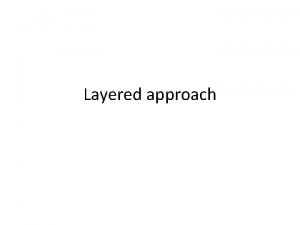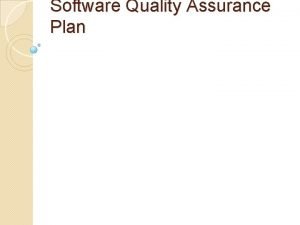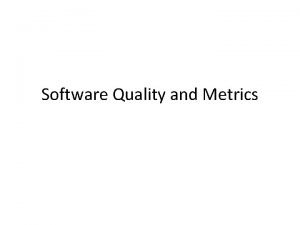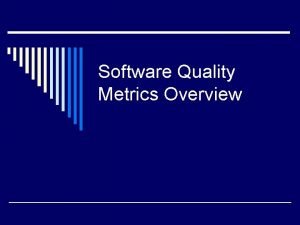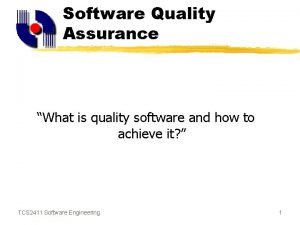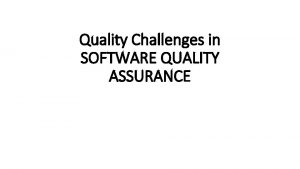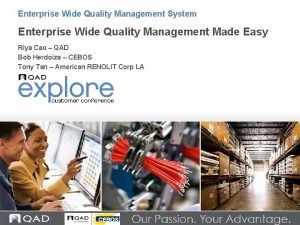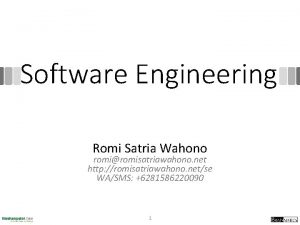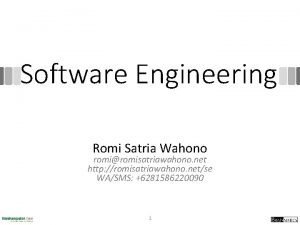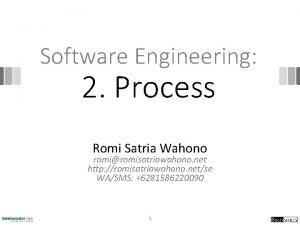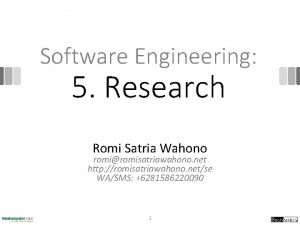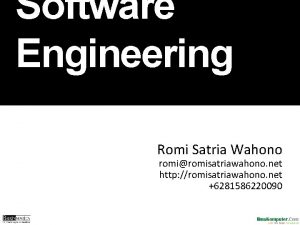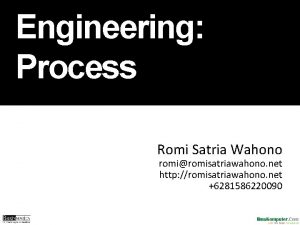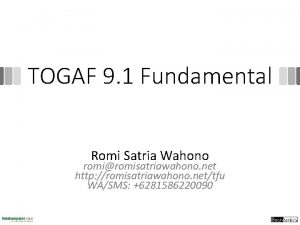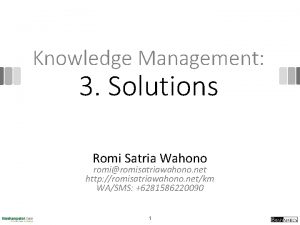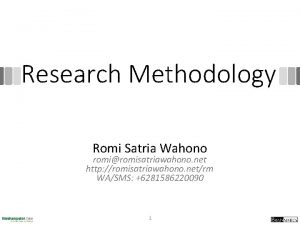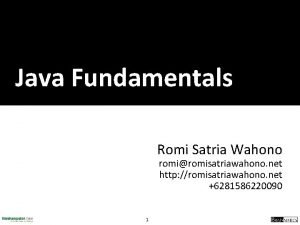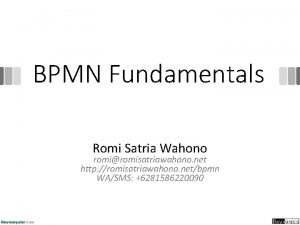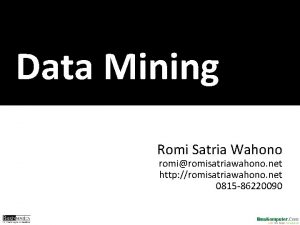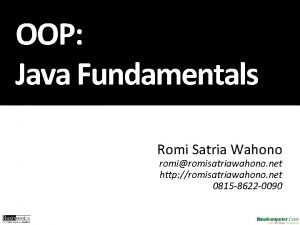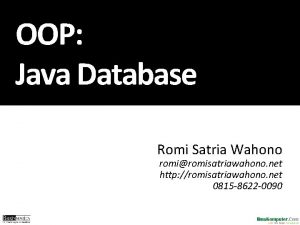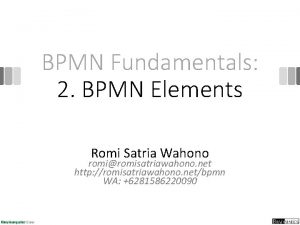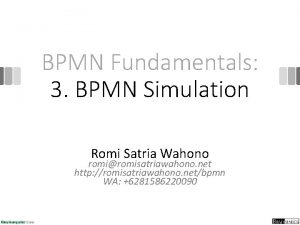Software Engineering 4 Quality Romi Satria Wahono romiromisatriawahono





































- Slides: 37

Software Engineering: 4. Quality Romi Satria Wahono romi@romisatriawahono. net http: //romisatriawahono. net/se WA/SMS: +6281586220090 1

Romi Satria Wahono • • SD Sompok Semarang (1987) SMPN 8 Semarang (1990) SMA Taruna Nusantara Magelang (1993) B. Eng, M. Eng and Ph. D in Software Engineering from Saitama University Japan (1994 -2004) Universiti Teknikal Malaysia Melaka (2014) Research Interests: Software Engineering, Machine Learning Founder dan Koordinator Ilmu. Komputer. Com Peneliti LIPI (2004 -2007) Founder dan CEO PT Brainmatics Cipta Informatika 2

Course Outline 1. Introduction 2. Process 3. Methodology 4. Quality 5. Research 3

4. Quality 4. 1 Software Quality 4. 2 Software Quality Metrics

4. 1 Software Quality 5

Definisi dari Sofware Quality • Software quality is (IEEE, 1991): 1. The degree to which a system, component, or process meets specified requirements 2. The degree to which a system, component, or process meets customer or user needs or expectations • Software quality measures how well software is designed (quality of design), and how well the software conforms to that design (quality of conformance) (Pressman, 2014) • Quality means conformance to requirements (Crosby, 1979) 6

Quality Concepts • Quality of Design Development • Quality of Conformance Design the characteristics that designer’s specify for an item • Quality Control Testing the degree to which the design specifications are followed during manufacturing 7 the series of inspections used throughout the development cycle to ensure that each work product meets the requirements

Software untuk Pesan Taxi 8

Software untuk Pesan Ojek (Go-Jek) 9

10

Software Office 11

Latihan Analisis Kasus • Ingat kembali handphone android/bb/iphone anda • Aplikasi apa yang didalamnya yang anda pikir sangat bermanfaat dan sesuai dengan kebutuhan anda? 12

4. 2 Software Quality Metrics 13

Software Quality Metrics Mc. Call Product (mengukur software dari kualitas produk jadinya) Boehm ISO 9126 Software Quality Process (mengukur software dari kematangan proses pengembangannya) 14 CMMI Lean Six Sigma ISO 9001

4. 2. 1 Product Aspect 15

Mc. Call’s Factor Model • Mc. Call’s factor model classifies all software requirements into 11 quality factors and 23 quality criteria • The 11 factors are grouped into three categories: 1. Product operation factors: Correctness, Reliability, Efficiency, Integrity, Usability 2. Product revision factors: Maintainability, Flexibility, Testability 3. Product transition factors: Portability, Reusability, Interoperability 16

Mc. Call’s Factor Model Quality Factor Quality Criteria Correctness Completeness, Consistency, Traceability Reliability Accuracy, Error Tolerance, Consistency, Simplicity Efficiency Execution Efficiently, Storage Efficiency Integrity Access Control, Access Audit Usability Communicativeness, Operability, Training Maintainability Consistency, Conciseness, Simplicity, Modularity, Self-documentation Testability Simplicity, Modularity, Instrumentation, Self-documentation Flexibility Expandability, Generality, Modularity, Self-documentation Portability Software/Hardware Independence, Self-documentation, Modularity Reusability Generality, Software/Hardware Independence, Modularity Interoperability Communication Commonality, Data Commonality, Modularity 17

18

Evans and Marciniak vs Deutsch and Willis Factor Models • The two factor models from the late 1980 s, alternatives to the Mc. Call classic factor model: 1. The Evans and Marciniak factor model 2. The Deutsch and Willis factor model • These alternative models suggest adding five factors to Mc. Call’s model • Two of these factors are very similar to two of Mc. Call’s factors; only three factors are “new”: 1. Both models add the factor Verifiability 2. The Deutsch and Willis model adds the factors Safety and Manageability 19

20

Boehm Factor Model (1978) • Boehm has defined 3 level of quality attributes: 1. 2. 3. Primary Uses Intermediate constructs Primitive constructs • Intermediate Constructs: 1. 2. 3. 4. 5. 6. 7. Portability Reliability Efficiency Usability Testability Understandibility Flexibility Primary Uses Intermediate Constructs 21 Primitive Constructs

ISO 9126 Factor Model 1. 2. 3. 4. 5. 6. Functionality Reliability Usability Efficiency Maintainability Portability 22

Mc Call vs Boehm vs ISO 9126 23

Contoh Pengukuran Product Fa = w 1 c 1 + w 2 c 2 + … + wncn F= Factor, W= Weight, C=Criteria http: //romisatriawahono. net/2006/06/05/teknik-pengukuran-kualitas-perangkat-lunak/ 24

4. 2. 2 Process Aspect 25

Capability Maturity Model Integration (CMMI) • CMMI adalah kerangka kerja (framework) yang bisa digunakan untuk mengembangkan proses di dalam perusahaan • Apa itu proses? Proses adalah cara kita melakukan suatu tugas • Misalnya, membuat proposal, menganalisa kebutuhan client, membuat kode program, dan kegiatan lainnya • Semua tata laksana kegiatan tersebut dikenal dengan nama proses atau prosedur • CMMI membantu kita untuk memperbaiki proses di perusahaan/organisasi kita. Dengan membaiknya proses, diharapkan produk yang dihasilkan akan ikut menjadi baik 26

Capability Maturity Model Integration (CMMI) 1. Level 1 – Initial tanpa prosedur dan planning, tidak konsisten 2. Level 2 – Repeatable ada manajemen, jaminan kualitas, prosedur, individual performance tanpa model formal 3. Level 3 – Defined proses terdefinisi, dan mengarah ke perbaikan proses secara kualitatif 4. Level 4 – Managed perbaikan dan prediksi proses secara kuantitatif 5. Level 5 – Optimizing memperbaiki proses secara berkesinambungan, inovatif, direncanakan, dianggarkan dan integral dalam proses organisasi 27

Capability Maturity Model Integration (CMMI) 28

Lean Six Sigma • Lean Six Sigma (LSS) is a powerful approach to improving the work we do • LSS improvement projects are performed by teams • Teams use a set of tools and techniques to understand problems and find solutions • Lean Six Sigma integrates tools and techniques from two proven process improvement methods 29

What is Six Sigma? • Six Sigma is a management philosophy based on meeting business objectives by reducing variation • A disciplined, data-driven methodology for decision making and process improvement • To increase process performance, you have to decrease variation Too early Too late Defects Delivery Time Spread of variation too wide compared to specifications Reduce variation Delivery Time Spread of variation narrow compared to specifications 30 • Greater predictability in the process • Less waste and rework, which lowers costs • Products and services that perform better and last longer • Happier customers

A General Purpose Problem-Solving Methodology: DMAIC Problem or goal statement (Y) Define Measure • Refine problem & goal statements. • Define project scope & boundaries. Analyze Improve Control • An improvement journey to achieve goals and resolve problems by discovering and understanding relationships between process inputs and outputs, such as Y = f(defect profile, yield) = f(review rate, method, complexity……) 31

Latihan Kognitif • Jelaskan bagaimana cara mengukur kualitas software! • Jelaskan level dari CMMI? 32

Latihan Analisis Kasus • PT ABC adalah sebuah perusahaan pengembang software yang memiliki manajemen yang sudah baik beserta berbagai prosedur baku untuk menjalankan prosesnya • Perusahaan tersebut juga memiliki jaminan kualitas terhadap produk yang dikembangkan • Akan tetapi masih mengandalkan 1 -2 orang programmernya untuk memproduksi software dengan kualitas yang baik • Masuk di CMMI level berapakah PT ABC tersebut? 33

Reference (Foundation) • Ian Sommerville, Software Engineering 10 th Edition, Addison -Wesley, 2015 • Roger S. Pressman, Software Engineering: A Practitioner’s Approach 8 th Edition, Mc. Graw-Hill, 2014 • P. Bourque and R. E. Fairley, eds. , Guide to the Software Engineering Body of Knowledge Version 3. 0, IEEE Computer Society, 2014 • Albert Endres dan Dieter Rombach, A Handbook of Software and Systems Engineering, Pearson Education Limited, 2003 • Yingxu Wang, Software Engineering Foundations: A Software Science Perspective, Auerbach Publications, Taylor & Francis Group, 2008

Reference (Process) • Alan Dennis et al, Systems Analysis and Design with UML – 4 th Edition, John Wiley and Sons, 2012 • Dan Pilone and Russ Miles, Head First Software Development, O’Reilly Media, 2008 • Barclay and Savage, Object-Oriented Design with UML and Java, Elsevier, 2004 • Kenneth E. Kendall and Julie E Kendall, Systems Analysis and Design 8 th Edition, Prentice Hall, 2010 • Hassan Gomaa, Software Modeling and Design: UML, Use Cases, Patterns, and Software Architectures, Cambridge University Press, 2011 • Layna Fischer (edt. ), BPMN 2. 0 Handbook Second Edition, Future Strategies, 2012

Reference (Quality) • Daniel Galin, Software Quality Assurance, Addison. Wesley, 2004 • Kshirasagar Naik and Priyadarshi Tripathy, Software Testing and Quality Assurance, John Wiley & Sons, Inc. , 2008 • Jeff Tian, Software Quality Engineering, John Wiley & Sons, Inc. , 2005 • G. Gordon Schulmeyer, Handbook of Software Quality Assurance Fourth Edition, Artech House, 2008

Reference (Research) • Christian W. Dawson, Project in Computing and Information System a Student Guide 2 nd Edition, Addison-Wesley, 2009 • Mikael Berndtsson, Jörgen Hansson, Björn Olsson, Björn Lundell, Thesis Projects - A Guide for Students in Computer Science and Information System 2 nd Edition, Springer-Verlag London Limited, 2008 • Mary Shaw, Writing Good Software Engineering Research Papers, Proceedings of the 25 th International Conference on Software Engineering, 2003 • C. Wohlin, P. Runeson, M. Host, M. C. Ohlsson, B. Regnell, and A. Wesslen, Experimentation in Software Engineering, Springer, 2012 • P. Runeson, M. Host, A. Rainer, and B. Regnell, Case Study Research in Software Engineering: Guiidelines and Examples, John Wiley & Sons, Inc. , 2012 37
 Romi satria wahono institute
Romi satria wahono institute Data mining romi satria wahono
Data mining romi satria wahono Kerangka pemikiran skripsi
Kerangka pemikiran skripsi Romi satria wahono
Romi satria wahono Romi satria wahono
Romi satria wahono Romi satrio wahono
Romi satrio wahono Romi satria wahono
Romi satria wahono Kaloperi
Kaloperi Brand equity charter
Brand equity charter Satria hadi lubis
Satria hadi lubis Quality methods and tools
Quality methods and tools Statistical quality assurance in software engineering
Statistical quality assurance in software engineering Quality assurance plan in software engineering
Quality assurance plan in software engineering Quality metrics in software engineering
Quality metrics in software engineering Computer based system engineering
Computer based system engineering Forward engineering and reverse engineering
Forward engineering and reverse engineering Software maintenance process models ppt
Software maintenance process models ppt What is software implementation in software engineering
What is software implementation in software engineering Metrics computer science
Metrics computer science Example of software crisis
Example of software crisis Software metrics and software metrology
Software metrics and software metrology Real time software design in software engineering
Real time software design in software engineering Design principles in software engineering
Design principles in software engineering Perform quality assurance
Perform quality assurance Project quality management pmp
Project quality management pmp Quality metrics pmp
Quality metrics pmp Total quality management seminar
Total quality management seminar Quality improvement vs quality assurance
Quality improvement vs quality assurance Quality assurance vs quality control
Quality assurance vs quality control Quality gurus
Quality gurus Crosby quality is free
Crosby quality is free What is tqm
What is tqm Software quality assurance metrics examples
Software quality assurance metrics examples Software quality infrastructure components
Software quality infrastructure components Software quality assurance iso standards
Software quality assurance iso standards Software quality challenges
Software quality challenges Maik nogens
Maik nogens Enterprise wide quality integrated management solution
Enterprise wide quality integrated management solution
